Exposing apps in Kubernetes: from services to Gateway API
Hi!
In this article I propose to have a look at how apps are exposed in Kubernetes. This is a back to basics mixed with new stuffs from the Kubernetes related project Gateway API. Hope you’ll enjoy it.
The Agenda:
- Exposing apps 101: The kubernetes service
- Exposing apps better with the Ingress
- What was wrong with Ingress again? And what do we do now? A sample with Cilium Gateway API
Let’s get started!
1. Exposing apps 101: The kubernetes service
In the Kubernetes landscape, we host application within kubernetes in pods. The pods contain… container(s) and usually, are also included in other kind of controllers such as deployments, daemonsets… But that’s not the topics of this article right ?
What if we want to access an app in a pod?
We could always find its IP and then try to access the app directly. After all, a simple kubectl get pod -o wide will give us this information.
df@df-2404lts:~$ k get pod -o wide
NAME READY STATUS RESTARTS AGE IP NODE NOMINATED NODE READINESS GATES
demo 1/1 Running 0 19s 100.64.6.7 aks-npuser2-14732456-vmss000008 <none> <none>
Except, well, as mentionned, pods are usually grouped under a controller umbrella, and then we have more than one which we can access, and second, we usually have a network overlay which makes the pods unaccessible directly, from a network standpoint.
Note: There’s one option on AKS for which the pods are directly accessible from a workload connected to the Vnet. It’s when the Azure CNI is configured, without overlay.
So that’s why kubernetes comes with a native object called the service. Typically, a service to expose the demo pod on port 8080 would look like that in yaml:
apiVersion: v1
kind: Service
metadata:
creationTimestamp: null
labels:
run: demo
name: demo
spec:
ports:
- port: 8080
protocol: TCP
targetPort: 80
selector:
run: demo
status:
loadBalancer: {}
The service is relying on the pod’s label to know which pod to select and to redirect trafic to:
df@df-2404lts:~$ k get pod demo --show-labels
NAME READY STATUS RESTARTS AGE LABELS
demo 1/1 Running 0 44m run=demo
In the case of the demo pod, it’s an nginx based pod, listening on port 80, hence the target port set to 80 while we configured the service with a 8080 port.
df@df-2404lts:~$ k get service demo
NAME TYPE CLUSTER-IP EXTERNAL-IP PORT(S) AGE
demo ClusterIP 100.65.106.57 <none> 8080/TCP 6s
The attentive reader will notice the <none> value for external IP, while we do have a cluster IP address. This pod lives on an AKS cluster configured with Azure CNI Overlay, as shown below, so it is not possible to access it directly.
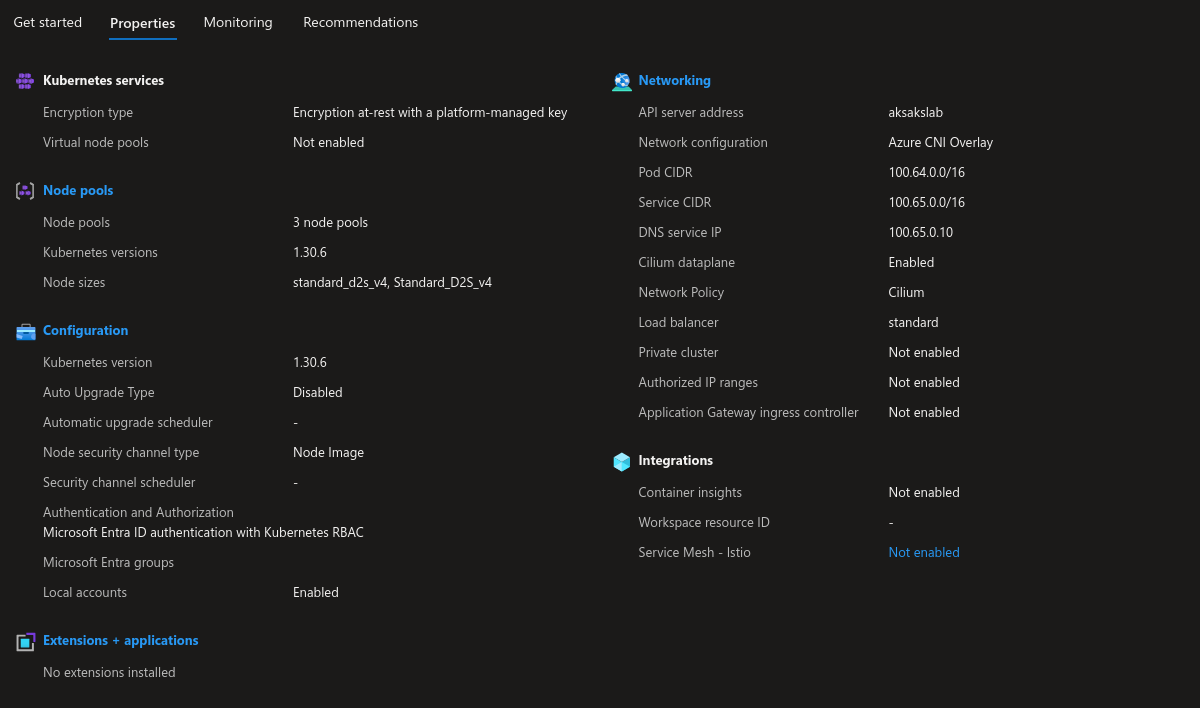
At this point we rely on the Cloud controller manager which allows us to leverage the cloud (in our case Azure) capabilities to provision a load balancer. For this we change the type of service. Instead of a ClusterIP type, we will specify a LoadBalancer type
df@df-2404lts:~$ kubectl get service demo -o json | jq .spec.type
"ClusterIP"
df@df-2404lts:~$ kubectl edit service demo
apiVersion: v1
kind: Service
metadata:
creationTimestamp: null
labels:
run: demo
name: demo
spec:
type: LoadBalancer
ports:
- port: 8080
protocol: TCP
targetPort: 80
selector:
run: demo
status:
loadBalancer: {}
df@df-2404lts:~$ kubectl get service demo
NAME TYPE CLUSTER-IP EXTERNAL-IP PORT(S) AGE
demo LoadBalancer 100.65.106.57 <pending> 8080:31560/TCP 20h
df@df-2404lts:~$ kubectl get service demo
NAME TYPE CLUSTER-IP EXTERNAL-IP PORT(S) AGE
demo LoadBalancer 100.65.106.57 74.179.240.209 8080:31560/TCP 20h
In our Azure environment, if the flows are allowed on the NSG(s), we should be able to curl the service. Note that the NSG associated with the node pool(s) will update automatically the rules so that the flow is opened. However, if there is another NSG on the subnet (which may be something by design), then, both NSGs should be configured to allow the traffic.
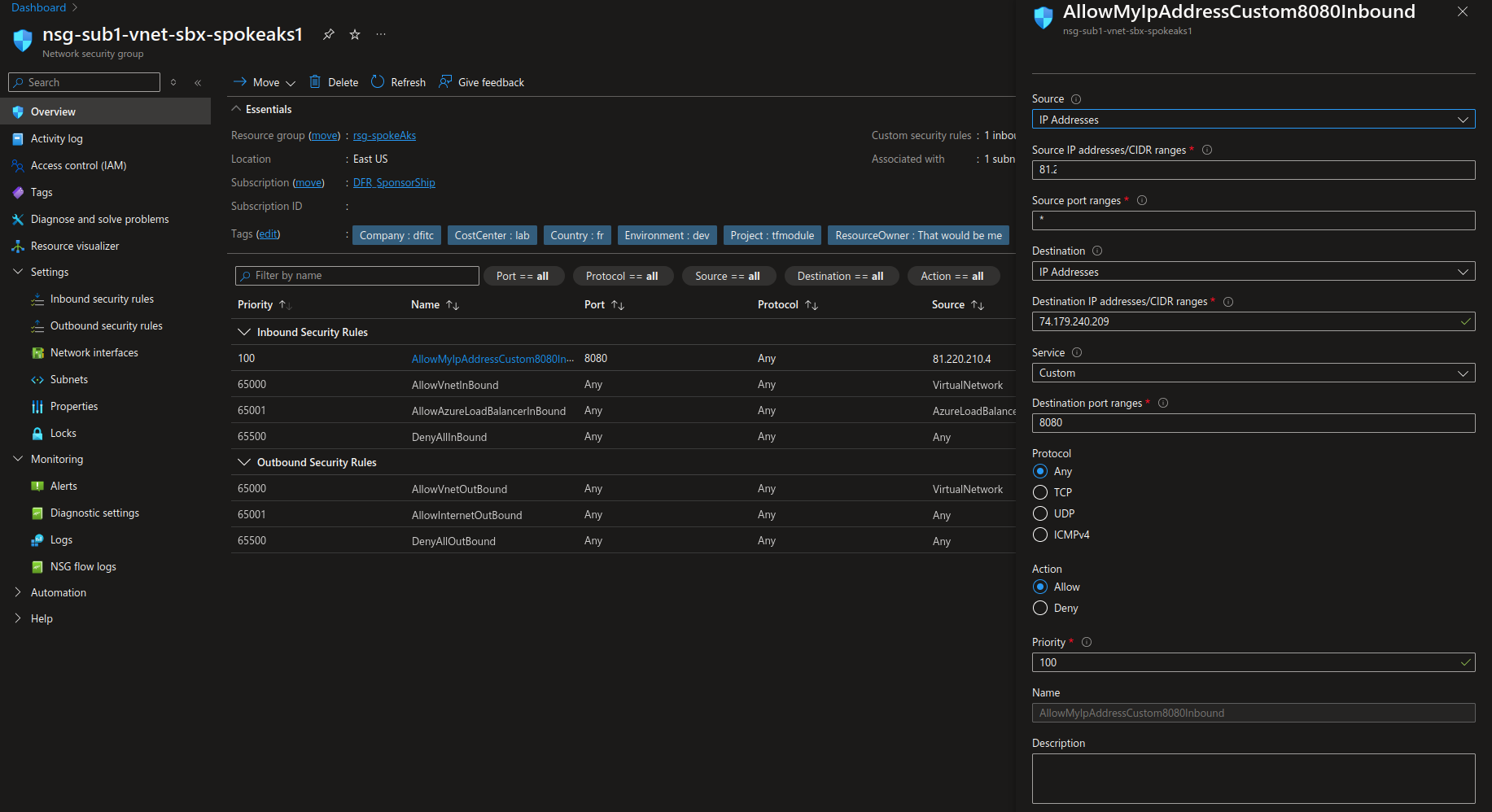
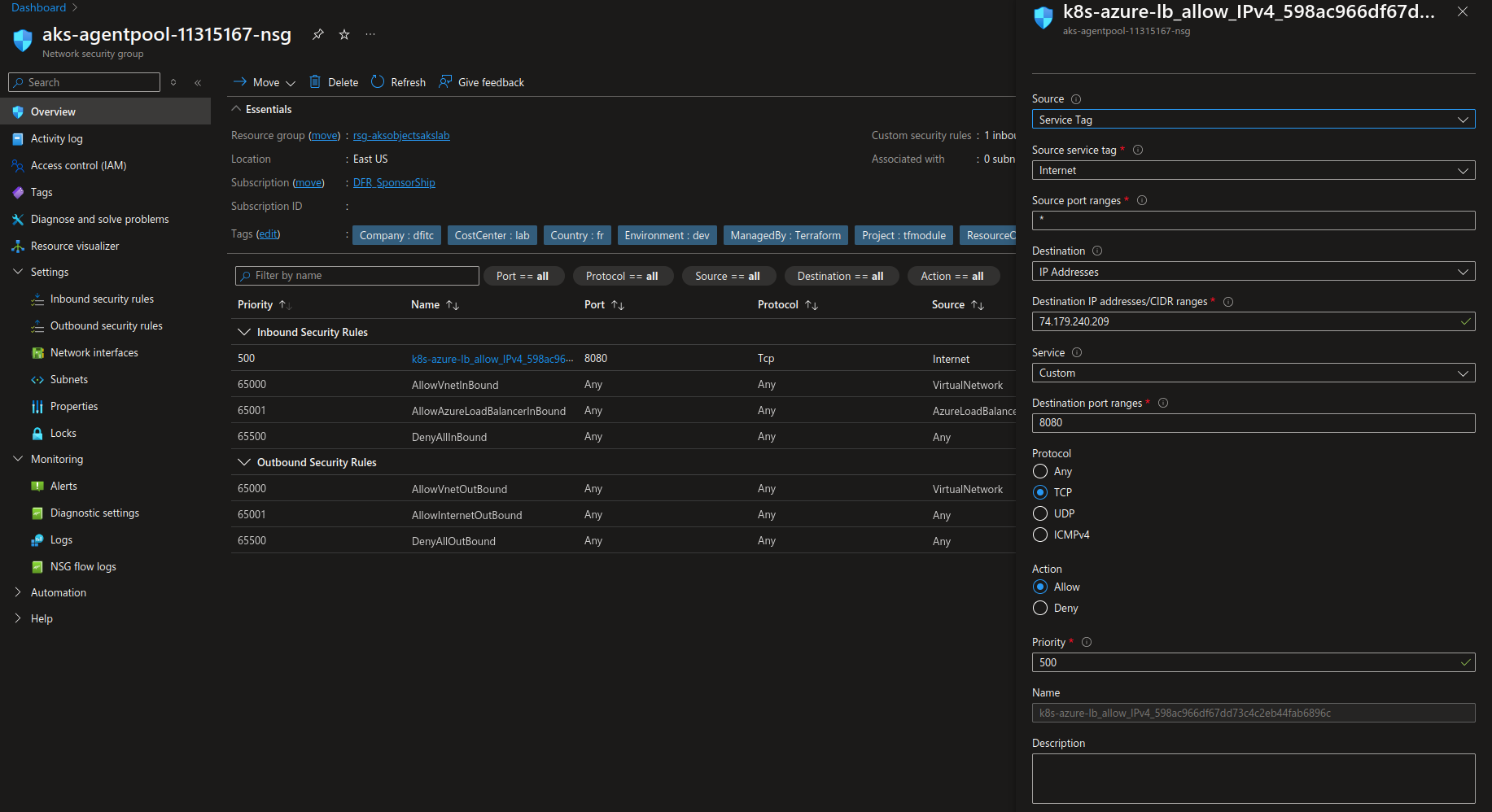
df@df-2404lts:~$ curl -i -X GET http://74.179.240.209:8080
HTTP/1.1 200 OK
Server: nginx/1.27.4
Date: Wed, 26 Mar 2025 07:25:21 GMT
Content-Type: text/html
Content-Length: 615
Last-Modified: Wed, 05 Feb 2025 11:06:32 GMT
Connection: keep-alive
ETag: "67a34638-267"
Accept-Ranges: bytes
<!DOCTYPE html>
<html>
<head>
<title>Welcome to nginx!</title>
<style>
html { color-scheme: light dark; }
body { width: 35em; margin: 0 auto;
font-family: Tahoma, Verdana, Arial, sans-serif; }
</style>
</head>
<body>
<h1>Welcome to nginx!</h1>
<p>If you see this page, the nginx web server is successfully installed and
working. Further configuration is required.</p>
<p>For online documentation and support please refer to
<a href="http://nginx.org/">nginx.org</a>.<br/>
Commercial support is available at
<a href="http://nginx.com/">nginx.com</a>.</p>
<p><em>Thank you for using nginx.</em></p>
</body>
</html>
It’s interesting to note that the cloud provider gives us options to configure the service through specific annotations, as in the sample below.
apiVersion: v1
kind: Service
metadata:
creationTimestamp: null
labels:
run: demo
name: demo-internal
annotations:
service.beta.kubernetes.io/azure-load-balancer-internal: "true"
service.beta.kubernetes.io/azure-load-balancer-internal-subnet: "sub2-vnet-sbx-spokeaks1"
service.beta.kubernetes.io/azure-load-balancer-ipv4: 172.21.10.132
spec:
type: LoadBalancer
ports:
- port: 8080
protocol: TCP
targetPort: 80
selector:
run: demo
status:
loadBalancer: {}
Again, through the cloud controller manager, we get an Azure Load Balancer, except that this time, it’s an internal one. Also because we specified the subnet and the IP, we can check that everything is as expected.
df@df-2404lts:~$ k get service demo-internal
NAME TYPE CLUSTER-IP EXTERNAL-IP PORT(S) AGE
demo-internal LoadBalancer 100.65.8.60 172.21.10.140 8080:30879/TCP 2m44s
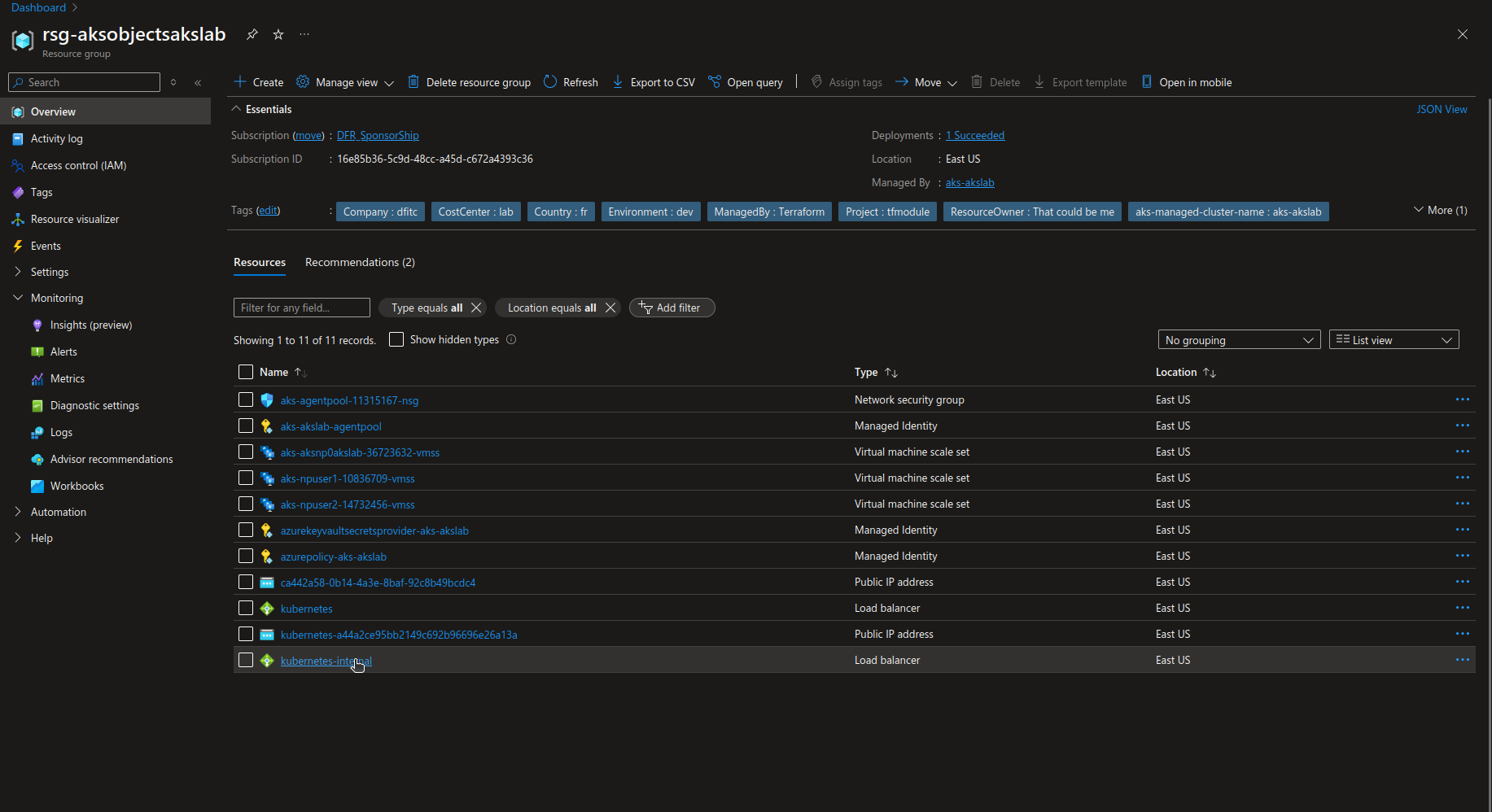
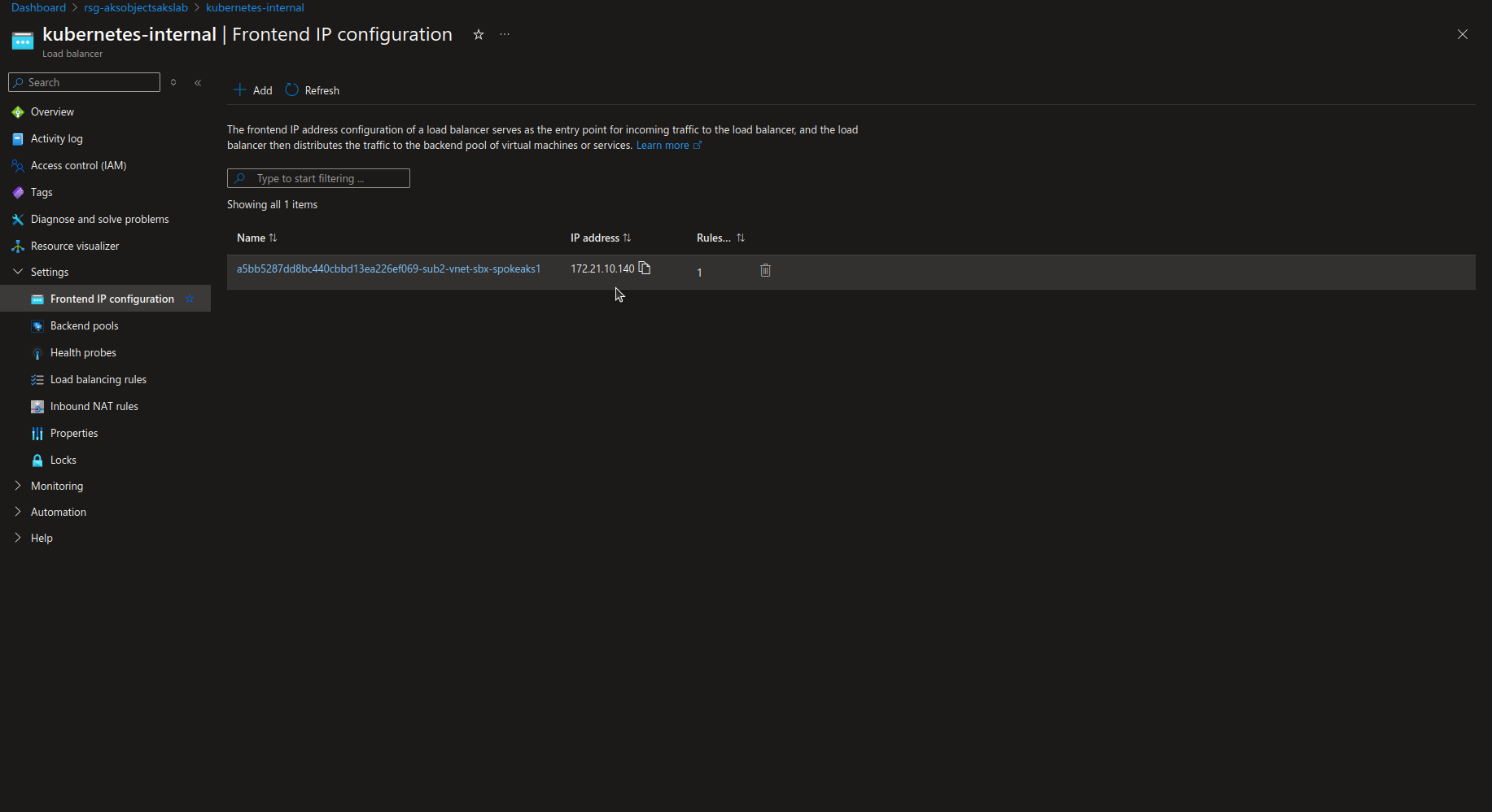

Ok, that’s quite nice but definitly not enough for web apps for wchich I may need to manage http path. And that’s for this kind of things that we had first the ingress.
2. Exposing apps better with the Ingress
The idea of the ingress is to provide this additional awareness of the L7 LB, which does not exist in default kubernetes services.
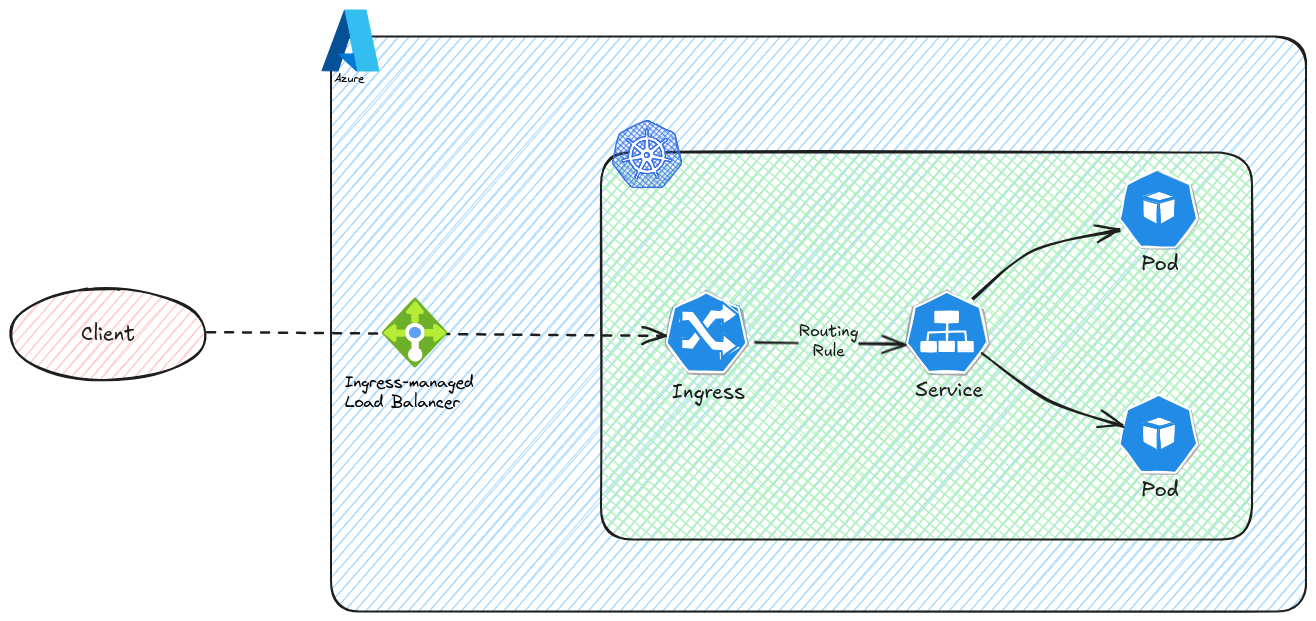
It relies on an Ingress controller which needs to be installed on the cluster. We don’t want to detail to much the installation of an Ingress Controller, there is already quite a lot of documentations about this, with the nginx ingress controller, and in an Azure environment.
To install a basic ingress controller we could use helm as below:
df@df-2404lts:~$ helm upgrade external-ingress ingress-nginx/ingress-nginx --namespace externalingress --create-namespace --set controller.service.annotations."service\.beta\.kubernetes\.io/azure-load-balancer-health-probe-request-path"=/healthz --install
Release "external-ingress" does not exist. Installing it now.
NAME: external-ingress
LAST DEPLOYED: Wed Mar 26 11:37:24 2025
NAMESPACE: externalingress
STATUS: deployed
REVISION: 1
TEST SUITE: None
NOTES:
The ingress-nginx controller has been installed.
It may take a few minutes for the load balancer IP to be available.
You can watch the status by running 'kubectl get service --namespace externalingress external-ingress-ingress-nginx-controller --output wide --watch'
An example Ingress that makes use of the controller:
apiVersion: networking.k8s.io/v1
kind: Ingress
metadata:
name: example
namespace: foo
spec:
ingressClassName: nginx
rules:
- host: www.example.com
http:
paths:
- pathType: Prefix
backend:
service:
name: exampleService
port:
number: 80
path: /
# This section is only required if TLS is to be enabled for the Ingress
tls:
- hosts:
- www.example.com
secretName: example-tls
If TLS is enabled for the Ingress, a Secret containing the certificate and key must also be provided:
apiVersion: v1
kind: Secret
metadata:
name: example-tls
namespace: foo
data:
tls.crt: <base64 encoded cert>
tls.key: <base64 encoded key>
type: kubernetes.io/tls
Once the installation is complete, we can see in the specified namespace the created resources.
df@df-2404lts:~$ k get all -n externalingress
NAME READY STATUS RESTARTS AGE
pod/external-ingress-ingress-nginx-controller-9bf4566c-cfnqf 1/1 Running 0 114m
NAME TYPE CLUSTER-IP EXTERNAL-IP PORT(S) AGE
service/external-ingress-ingress-nginx-controller LoadBalancer 100.65.73.213 57.152.85.14 80:30177/TCP,443:30403/TCP 114m
service/external-ingress-ingress-nginx-controller-admission ClusterIP 100.65.214.0 <none> 443/TCP 114m
NAME READY UP-TO-DATE AVAILABLE AGE
deployment.apps/external-ingress-ingress-nginx-controller 1/1 1 1 114m
NAME DESIRED CURRENT READY AGE
replicaset.apps/external-ingress-ingress-nginx-controller-9bf4566c 1 1 1 114m
We can also see that we have a default ingress class. We’ll come back to this later.
df@df-2404lts:~$ k get ingressclasses.networking.k8s.io
NAME CONTROLLER PARAMETERS AGE
nginx k8s.io/ingress-nginx <none> 107m
Now let’s create some apps to illustrate our purpose.
We will use nginx based deployment, with config map for a touch of customization.
apiVersion: v1
kind: Namespace
metadata:
name: ingressapp-demo
---
apiVersion: v1
kind: ConfigMap
metadata:
name: index-html-main
namespace: ingressapp-demo
data:
index.html: |
<html>
<h1>Ingress Demo</h1>
</br>
<h2>Hi! This is the main page of the app </h2>
<img src="https://japancraft.co.uk/media/catalog/product/cache/1/image/1800x/040ec09b1e35df139433887a97daa66f/b/a/bans63030_4.jpeg" />
</html
---
apiVersion: v1
kind: ConfigMap
metadata:
name: index-html-doc
namespace: ingressapp-demo
data:
index.html: |
<html>
<h1>Ingress Demo</h1>
</br>
<h2>Hi! This is the doc page of the app </h2>
<img src="https://www.previewsworld.com/SiteImage/FBCatalogImage/STL205689.jpg" />
</html
---
apiVersion: apps/v1
kind: Deployment
metadata:
creationTimestamp: null
labels:
app: main
name: main
namespace: ingressapp-demo
spec:
replicas: 1
selector:
matchLabels:
app: main
strategy: {}
template:
metadata:
creationTimestamp: null
labels:
app: main
spec:
volumes:
- name: nginx-index-file
configMap:
name: index-html-main
containers:
- image: nginx
name: nginx
volumeMounts:
- name: nginx-index-file
mountPath: /usr/share/nginx/html/
resources: {}
status: {}
---
apiVersion: apps/v1
kind: Deployment
metadata:
creationTimestamp: null
labels:
app: docpage
name: docpage
namespace: ingressapp-demo
spec:
replicas: 1
selector:
matchLabels:
app: docpage
strategy: {}
template:
metadata:
creationTimestamp: null
labels:
app: docpage
spec:
volumes:
- name: nginx-index-file
configMap:
name: index-html-doc
containers:
- image: nginx
name: nginx
volumeMounts:
- name: nginx-index-file
mountPath: /usr/share/nginx/html/
resources: {}
status: {}
Once the application is deployed, we want to expose internally with ClusterIP services:
apiVersion: v1
kind: Service
metadata:
creationTimestamp: null
labels:
app: main
name: main
namespace: ingressapp-demo
spec:
ports:
- port: 8080
protocol: TCP
targetPort: 80
selector:
app: main
status:
loadBalancer: {}
---
apiVersion: v1
kind: Service
metadata:
creationTimestamp: null
labels:
app: docpage
name: docpage
namespace: ingressapp-demo
spec:
ports:
- port: 8090
protocol: TCP
targetPort: 80
selector:
app: docpage
status:
loadBalancer: {}
We can verify that our services are accessible from a pod:
df@df-2404lts:~$ k get service -n ingressapp-demo
NAME TYPE CLUSTER-IP EXTERNAL-IP PORT(S) AGE
docpage ClusterIP 100.65.182.19 <none> 8090/TCP 8m37s
main ClusterIP 100.65.133.247 <none> 8080/TCP 9m4s
df@df-2404lts:~$ k exec client -- curl http://docpage.ingressapp-demo.svc.cluster.local:8090
% Total % Received % Xferd Average Speed Time Time Time Current
Dload Upload Total Spent Left Speed
100 171 100 171 0 0 9436 <html>--:-- --:--:-- --:--:-- 0
<h1>Ingress Demo</h1>
</br>
<h2>Hi! This is the doc page of the app </h2>
<img src="https://www.previewsworld.com/SiteImage/FBCatalogImage/STL205689.jpg" />
</html
0 --:--:-- --:--:-- --:--:-- 9500
df@df-2404lts:~/$ k exec client -- curl http://main.ingressapp-demo.svc.cluster.local:8080
% Total % Received % Xferd Average Speed Time Time Time Current
Dload Upload Total Spent Left Speed
0 0 0 0 0 0 0 0 --:--:-- --:--:-- --:--:-- 0<html>
<h1>Ingress Demo</h1>
</br>
<h2>Hi! This is the main page of the app </h2>
<img src="https://japancraft.co.uk/media/catalog/product/cache/1/image/1800x/040ec09b1e35df139433887a97daa66f/b/a/bans63030_4.jpeg" />
</html
100 224 100 224 0 0 15361 0 --:--:-- --:--:-- --:--:-- 16000
And now we want to create an ingress, so that the main page is accessible on the /main path, and the doc page is accessible on the /doc path
apiVersion: networking.k8s.io/v1
kind: Ingress
metadata:
name: ingress-demo
namespace: ingressapp-demo
annotations:
nginx.ingress.kubernetes.io/ssl-redirect: "false"
#nginx.ingress.kubernetes.io/rewrite-target: /
nginx.ingress.kubernetes.io/use-regex: "true"
nginx.ingress.kubernetes.io/rewrite-target: /$2
spec:
ingressClassName: nginx
rules:
- http:
paths:
- path: /main
pathType: Prefix
backend:
service:
name: main
port:
number: 8080
- path: /doc
pathType: Prefix
backend:
service:
name: docpage
port:
number: 8090
- path: /
pathType: Prefix
backend:
service:
name: main
port:
number: 8080


At this point we are now able to expose application publicly.
If we want to expose privately, since the service behind the ingress controller is always the same, we need another ingress controller instance, with an ingress class different from the one already present.
We can install another instance as shown below, by adding the setting the argument controller.ingressClassResource.name="internal-nginx" and controller.ingressClassResource.controllerValue="k8s.io/ingress-nginx-internal".
Also, to leverage the capabilities of the cloud controller manager, we can insert the service annotations used earlier.
controller.service.annotations."service\.beta\.kubernetes\.io/azure-load-balancer-internal"=truecontroller.service.annotations."service\.beta\.kubernetes\.io/azure-load-balancer-internal-subnet"="sub2-vnet-sbx-spokeaks1"
df@df-2404lts:~$ helm upgrade internal-ingress ingress-nginx/ingress-nginx --namespace internalingress --create-namespace --set controller.service.annotations."service\.beta\.kubernetes\.io/azure-load-balancer-health-probe-request-path"=/healthz --set controller.service.annotations."service\.beta\.kubernetes\.io/azure-load-balancer-internal"=true --set controller.service.annotations."service\.beta\.kubernetes\.io/azure-load-balancer-internal-subnet"="sub2-vnet-sbx-spokeaks1" --set controller.ingressClassResource.name="internal-nginx" --set controller.ingressClassResource.controllerValue="k8s.io/ingress-nginx-internal" --install
Release "internal-ingress" does not exist. Installing it now.
NAME: internal-ingress
LAST DEPLOYED: Wed Mar 26 13:26:02 2025
NAMESPACE: internalingress
STATUS: deployed
REVISION: 1
TEST SUITE: None
NOTES:
The ingress-nginx controller has been installed.
It may take a few minutes for the load balancer IP to be available.
You can watch the status by running 'kubectl get service --namespace internalingress internal-ingress-ingress-nginx-controller --output wide --watch'
An example Ingress that makes use of the controller:
apiVersion: networking.k8s.io/v1
kind: Ingress
metadata:
name: example
namespace: foo
spec:
ingressClassName: internal-nginx
rules:
- host: www.example.com
http:
paths:
- pathType: Prefix
backend:
service:
name: exampleService
port:
number: 80
path: /
# This section is only required if TLS is to be enabled for the Ingress
tls:
- hosts:
- www.example.com
secretName: example-tls
If TLS is enabled for the Ingress, a Secret containing the certificate and key must also be provided:
apiVersion: v1
kind: Secret
metadata:
name: example-tls
namespace: foo
data:
tls.crt: <base64 encoded cert>
tls.key: <base64 encoded key>
type: kubernetes.io/tls
We now have 2 ingress controller classes, and 2 ingress controller instances in different namespace
df@df-2404lts:~$ k get ingressclasses.networking.k8s.io
NAME CONTROLLER PARAMETERS AGE
internal-nginx k8s.io/ingress-nginx-internal <none> 3h29m
nginx k8s.io/ingress-nginx <none> 5h17m
df@df-2404lts:~$ helm ls -A
NAME NAMESPACE REVISION UPDATED STATUS CHART APP VERSION
external-ingress externalingress 1 2025-03-26 11:37:24.18934227 +0100 CET deployed ingress-nginx-4.12.1 1.12.1
internal-ingress internalingress 1 2025-03-26 13:26:02.685498353 +0100 CET deployed ingress-nginx-4.12.1 1.12.1
df@df-2404lts:~$ k get service -A | grep ingress-nginx
externalingress external-ingress-ingress-nginx-controller LoadBalancer 100.65.73.213 57.152.85.14 80:30177/TCP,443:30403/TCP 5h22m
externalingress external-ingress-ingress-nginx-controller-admission ClusterIP 100.65.214.0 <none> 443/TCP 5h22m
internalingress internal-ingress-ingress-nginx-controller LoadBalancer 100.65.109.85 172.21.10.132 80:32713/TCP,443:32593/TCP 3h34m
internalingress internal-ingress-ingress-nginx-controller-admission ClusterIP 100.65.24.220 <none> 443/TCP 3h34m
df@df-2404lts:~$
We can create another ingress with the internal-nginx class.
apiVersion: networking.k8s.io/v1
kind: Ingress
metadata:
name: ingress-demo-internal
namespace: ingressapp-demo
annotations:
nginx.ingress.kubernetes.io/ssl-redirect: "false"
nginx.ingress.kubernetes.io/use-regex: "true"
nginx.ingress.kubernetes.io/rewrite-target: /$2
spec:
ingressClassName: internal-nginx
rules:
- http:
paths:
- path: /main
pathType: Prefix
backend:
service:
name: main
port:
number: 8080
- path: /doc
pathType: Prefix
backend:
service:
name: docpage
port:
number: 8090
- path: /
pathType: Prefix
backend:
service:
name: main
port:
number: 8080
And from a network that can access the internel load balancer, check the access to the application
david [ ~ ]$ curl http://172.21.10.132/main
<html>
<h1>Ingress Demo</h1>
</br>
<h2>Hi! This is the main page of the app </h2>
<img src="https://japancraft.co.uk/media/catalog/product/cache/1/image/1800x/040ec09b1e35df139433887a97daa66f/b/a/bans63030_4.jpeg" />
</html
david [ ~ ]$ curl http://172.21.10.132/doc
<html>
<h1>Ingress Demo</h1>
</br>
<h2>Hi! This is the doc page of the app </h2>
<img src="https://www.previewsworld.com/SiteImage/FBCatalogImage/STL205689.jpg" />
</html
david [ ~ ]$
And that was the ingress. But nowadays, we talk more and more about the Gateway API. Let’s have a look.
3. What was wrong with Ingress again? And what do we do now? A sample with Cilium Gateway API
So we’ve seen the basic kubernetes service, and also how to manage L7 path with ingress controller. We’ve also seen that to we get one instance of a controller for all the ingress object afterward, except if we install additional ingress controller and define some ingress class. That’s one problem of the ingress controller, it is not really well designed for multi-tenant cluster. If one team need to manage the ingress controller, it should have access to the related object. That’s fine, but what happened when another team also need access? Then either they share access, or they both have their own instance. It can work but it’s not necessarily something that anone can do.
Also, because ingress has been around for a time now, it is higly likely that each providers bring their own customization, often with CRDs or specifics annotations. So we kind of lost the standard along the way.
Those are topics that the Gateway API is aiming to address. We discussed that a bit in a previous article about service mesh, where we took from the Kubernetes documentation a nice schema explaining how the role separation is addressed in the Gateway API architecture.

while the Ingress controller required a specific installation, and were more or less provider specific, the gateway API is defined by CRDs that define the differents opbjects related to the Gateway API.
The really intersting part here is that we have something that is designed to be used by different teams.
- Infrastructure operators will define the Gateway Class which define what features the Gateway can have
- Cluster operators, or sometimes even some developers, will create gateway based on the gateway class. Some customizations are possibel, also based on CRDs (more on that just after)
- Dev teams just need to know how the apps should be exposed, and refers the available gateways(s) for the jobs.
We mention CRDs, to define the Gateway API capabilities. Those are defined in the Gateway API documentation and are available on Github. That’s where we’ll find:
- The gateway class
- The gateway
and then the different object to manage apps exposure:
- HTTPRoute
- grpcRoutes
- TLSRoute
So there are stil some requirements to use a Gateway API, and the first one is to have those CRDs installed on the target cluster. This can be done quite easily:
kubectl apply -f https://raw.githubusercontent.com/kubernetes-sigs/gateway-api/v1.2.1/config/crd/standard/gateway.networking.k8s.io_gatewayclasses.yaml
kubectl apply -f https://raw.githubusercontent.com/kubernetes-sigs/gateway-api/v1.2.1/config/crd/standard/gateway.networking.k8s.io_gateways.yaml
kubectl apply -f https://raw.githubusercontent.com/kubernetes-sigs/gateway-api/v1.2.1/config/crd/standard/gateway.networking.k8s.io_httproutes.yaml
kubectl apply -f https://raw.githubusercontent.com/kubernetes-sigs/gateway-api/v1.2.1/config/crd/standard/gateway.networking.k8s.io_referencegrants.yaml
kubectl apply -f https://raw.githubusercontent.com/kubernetes-sigs/gateway-api/v1.2.1/config/crd/standard/gateway.networking.k8s.io_grpcroutes.yaml
kubectl apply -f https://raw.githubusercontent.com/kubernetes-sigs/gateway-api/v1.2.1/config/crd/experimental/gateway.networking.k8s.io_tlsroutes.yaml
To try a bit of the Gateway API, we can use Cilium. In our case, a byocni on an AKS cluster, with specification to install the Gateway API. It will implies that the kube-proxy replacement is enabled.
resource "azapi_update_resource" "kube_proxy_disabled" {
for_each = { for k, v in var.AksConfig : k => v if v.CustomizeKubeproxyConfig }
resource_id = module.AKS[each.key].KubeId
type = "Microsoft.ContainerService/managedClusters@2024-06-02-preview"
body = {
properties = {
networkProfile = {
kubeProxyConfig = {
enabled = false
}
}
}
}
}
helm upgrade cilium ./cilium \
--namespace kube-system \
--reuse-values \
--set kubeProxyReplacement=true \
--set gatewayAPI.enabled=true
If everything is installed correctly, cilium cli should be green:
df@df-2404lts:~$ cilium status
/¯¯\
/¯¯\__/¯¯\ Cilium: OK
\__/¯¯\__/ Operator: OK
/¯¯\__/¯¯\ Envoy DaemonSet: OK
\__/¯¯\__/ Hubble Relay: OK
\__/ ClusterMesh: disabled
DaemonSet cilium Desired: 3, Ready: 3/3, Available: 3/3
DaemonSet cilium-envoy Desired: 3, Ready: 3/3, Available: 3/3
Deployment cilium-operator Desired: 2, Ready: 2/2, Available: 2/2
Deployment hubble-relay Desired: 1, Ready: 1/1, Available: 1/1
Deployment hubble-ui Desired: 1, Ready: 1/1, Available: 1/1
Containers: cilium Running: 3
cilium-envoy Running: 3
cilium-operator Running: 2
hubble-relay Running: 1
hubble-ui Running: 1
Cluster Pods: 51/51 managed by Cilium
Helm chart version: 1.17.2
Image versions cilium quay.io/cilium/cilium:v1.17.2@sha256:3c4c9932b5d8368619cb922a497ff2ebc8def5f41c18e410bcc84025fcd385b1: 3
cilium-envoy quay.io/cilium/cilium-envoy:v1.31.5-1741765102-efed3defcc70ab5b263a0fc44c93d316b846a211@sha256:377c78c13d2731f3720f931721ee309159e782d882251709cb0fac3b42c03f4b: 3
cilium-operator quay.io/cilium/operator-generic:v1.17.2@sha256:81f2d7198366e8dec2903a3a8361e4c68d47d19c68a0d42f0b7b6e3f0523f249: 2
hubble-relay quay.io/cilium/hubble-relay:v1.17.2@sha256:42a8db5c256c516cacb5b8937c321b2373ad7a6b0a1e5a5120d5028433d586cc: 1
hubble-ui quay.io/cilium/hubble-ui-backend:v0.13.2@sha256:a034b7e98e6ea796ed26df8f4e71f83fc16465a19d166eff67a03b822c0bfa15: 1
hubble-ui quay.io/cilium/hubble-ui:v0.13.2@sha256:9e37c1296b802830834cc87342a9182ccbb71ffebb711971e849221bd9d59392: 1
df@df-2404lts:~$ cilium config view | grep "enable-gateway-api"
enable-gateway-api true
enable-gateway-api-alpn false
enable-gateway-api-app-protocol false
enable-gateway-api-proxy-protocol false
enable-gateway-api-secrets-sync true
And we should have a gatewayclass available.
df@df-2404lts:~$ k get gatewayclasses.gateway.networking.k8s.io
NAME CONTROLLER ACCEPTED AGE
cilium io.cilium/gateway-controller True 2d8h
If the Gateway is in a pending status, it may help to restart cilium related pods, as mentioned on the Cilium doc. I’ll admit that I did miss this one, and solve it with an AKS restart 😅.
kubectl -n kube-system rollout restart deployment/cilium-operator
kubectl -n kube-system rollout restart ds/cilium
If it’s working, we can move along with the creation of a gateway.
---
apiVersion: gateway.networking.k8s.io/v1
kind: Gateway
metadata:
name: demo-gw
namespace: gatewayapi-test
spec:
gatewayClassName: cilium
listeners:
- protocol: HTTP
port: 80
name: web-gw
allowedRoutes:
namespaces:
from: Same
Then with the following sample app,
apiVersion: v1
kind: Namespace
metadata:
creationTimestamp: null
name: gatewayapi-test
spec: {}
status: {}
---
apiVersion: v1
kind: ConfigMap
metadata:
name: index-html-configmap1
namespace: gatewayapi-test
data:
index.html: |
<html>
<h1>Welcome to Demo App 1</h1>
</br>
<h2>This is a demo to illustrate Gateway API </h2>
<img src="https://riseofgunpla.com/wp-content/uploads/2024/12/In-ERA-Lizard-9.jpg" />
</html
---
apiVersion: apps/v1
kind: Deployment
metadata:
labels:
app: demoapp1
name: demoapp1
namespace: gatewayapi-test
spec:
replicas: 3
selector:
matchLabels:
app: demoapp1
template:
metadata:
labels:
app: demoapp1
spec:
volumes:
- name: nginx-index-file
configMap:
name: index-html-configmap1
containers:
- image: nginx
name: nginx
volumeMounts:
- name: nginx-index-file
mountPath: /usr/share/nginx/html
---
apiVersion: v1
kind: Service
metadata:
name: demosvcapp1
namespace: gatewayapi-test
annotations:
service.cilium.io/global: "true"
service.cilium.io/shared: "true"
spec:
type: ClusterIP
ports:
- port: 8080
targetPort: 80
protocol: TCP
selector:
app: demoapp1
---
And an HTTPRoute as below
apiVersion: gateway.networking.k8s.io/v1
kind: HTTPRoute
metadata:
name: example-httproute
namespace: gatewayapi-test
spec:
parentRefs:
- name: demo-gw
hostnames:
- "gapitest.app.teknews.cloud"
rules:
- backendRefs:
- name: demosvcapp1
port: 8080
kind: Service
We have the simplest app with a Gateway API. Again, if the Gateway class is working, we should have a Gateway, and an associated service.
df@df-2404lts:~$ k get gateway -n gatewayapi-test
NAME CLASS ADDRESS PROGRAMMED AGE
demo-gw cilium 48.216.184.196 True 2d7h
df@df-2404lts:~$ k get service -n gatewayapi-test | grep cilium
cilium-gateway-demo-gw LoadBalancer 100.67.26.63 48.216.184.196 80:30994/TCP 2d7h
And the application should be available on http://gapi.app.teknews.cloud, under the condition that there is a DNS record for this hostname.
df@df-2404lts:~$ nslookup gapitest.app.teknews.cloud
Server: 127.0.0.53
Address: 127.0.0.53#53
Non-authoritative answer:
Name: gapitest.app.teknews.cloud
Address: 48.216.184.196
df@df-2404lts:~$ curl http://gapitest.app.teknews.cloud
<html>
<h1>Welcome to Demo App 1</h1>
</br>
<h2>This is a demo to illustrate Gateway API </h2>
<img src="https://riseofgunpla.com/wp-content/uploads/2024/12/In-ERA-Lizard-9.jpg" />
</html
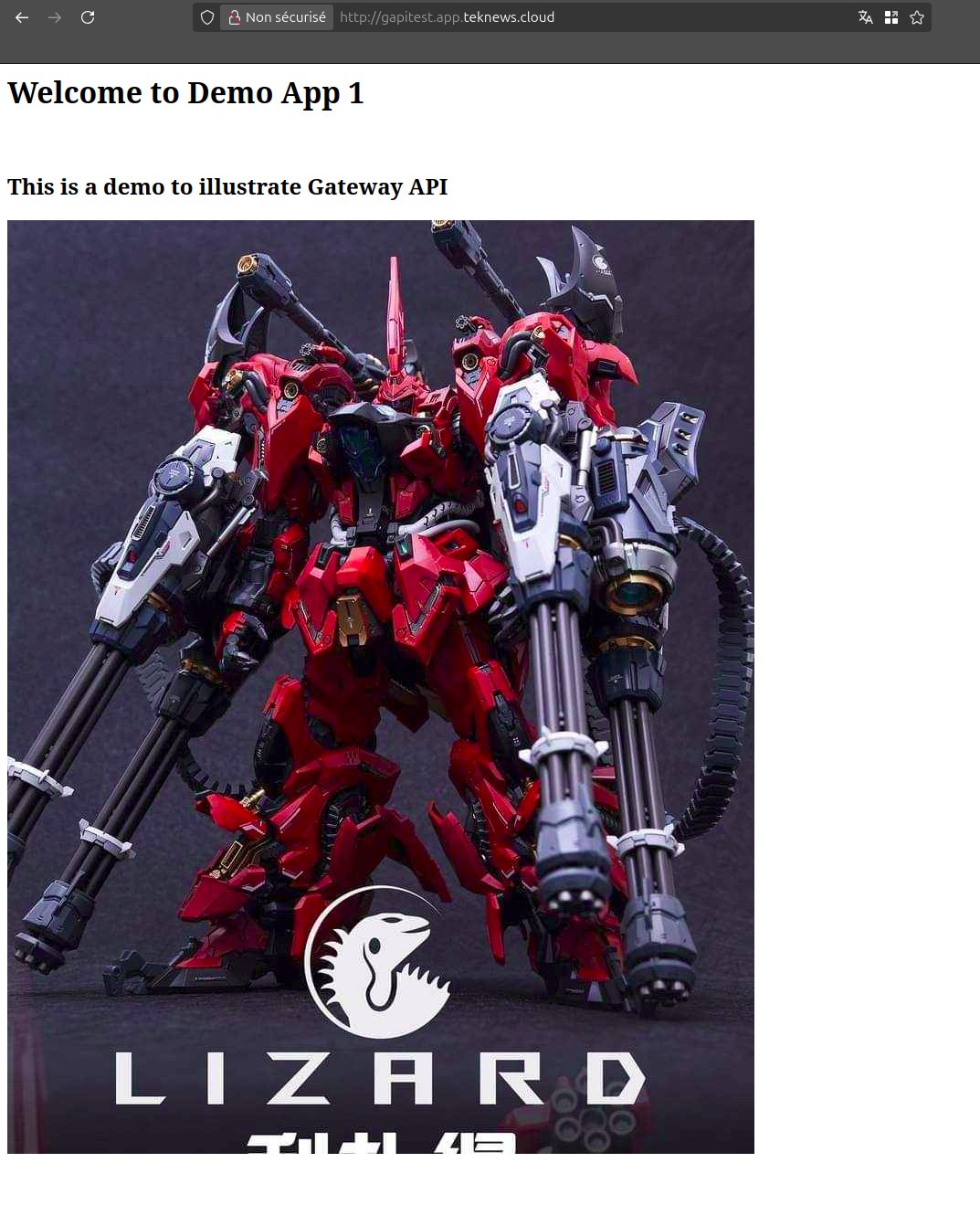
Before going to a (temporary) conclusion, 2 things I’d like to discuss today.
First, there is a native option to manage wieght for an application. This is quite well demonstrated on the Cilium samples. With an HTTPRoute as below, it’s possible to chose the wieght of 1 service in coomparison to another
---
apiVersion: gateway.networking.k8s.io/v1
kind: Gateway
metadata:
name: cilium-gw
spec:
gatewayClassName: cilium
listeners:
- protocol: HTTP
port: 80
name: web-gw-echo
allowedRoutes:
namespaces:
from: Same
---
apiVersion: gateway.networking.k8s.io/v1
kind: HTTPRoute
metadata:
name: example-route-1
spec:
parentRefs:
- name: cilium-gw
rules:
- matches:
- path:
type: PathPrefix
value: /echo
backendRefs:
- kind: Service
name: echo-1
port: 8080
weight: 50
- kind: Service
name: echo-2
port: 8090
weight: 50
Second, we have a specific CRD to customize the Gateway. In Cilium case, this is the CiliumGatewayClassConfig CRD.
---
apiVersion: apiextensions.k8s.io/v1
kind: CustomResourceDefinition
metadata:
annotations:
controller-gen.kubebuilder.io/version: v0.16.5
name: ciliumgatewayclassconfigs.cilium.io
spec:
group: cilium.io
names:
categories:
- cilium
kind: CiliumGatewayClassConfig
listKind: CiliumGatewayClassConfigList
plural: ciliumgatewayclassconfigs
shortNames:
- cgcc
singular: ciliumgatewayclassconfig
scope: Namespaced
versions:
- additionalPrinterColumns:
- jsonPath: .status.conditions[?(@.type=="Accepted")].status
name: Accepted
type: string
- jsonPath: .metadata.creationTimestamp
name: Age
type: date
- jsonPath: .spec.description
name: Description
priority: 1
type: string
name: v2alpha1
schema:
openAPIV3Schema:
description: |-
CiliumGatewayClassConfig is a Kubernetes third-party resource which
is used to configure Gateways owned by GatewayClass.
properties:
apiVersion:
description: |-
APIVersion defines the versioned schema of this representation of an object.
Servers should convert recognized schemas to the latest internal value, and
may reject unrecognized values.
More info: https://git.k8s.io/community/contributors/devel/sig-architecture/api-conventions.md#resources
type: string
kind:
description: |-
Kind is a string value representing the REST resource this object represents.
Servers may infer this from the endpoint the client submits requests to.
Cannot be updated.
In CamelCase.
More info: https://git.k8s.io/community/contributors/devel/sig-architecture/api-conventions.md#types-kinds
type: string
metadata:
type: object
spec:
description: Spec is a human-readable of a GatewayClass configuration.
properties:
description:
description: Description helps describe a GatewayClass configuration
with more details.
maxLength: 64
type: string
service:
description: |-
Service specifies the configuration for the generated Service.
Note that not all fields from upstream Service.Spec are supported
properties:
allocateLoadBalancerNodePorts:
description: Sets the Service.Spec.AllocateLoadBalancerNodePorts
in generated Service objects to the given value.
type: boolean
externalTrafficPolicy:
default: Cluster
description: Sets the Service.Spec.ExternalTrafficPolicy in generated
Service objects to the given value.
type: string
ipFamilies:
description: Sets the Service.Spec.IPFamilies in generated Service
objects to the given value.
items:
description: |-
IPFamily represents the IP Family (IPv4 or IPv6). This type is used
to express the family of an IP expressed by a type (e.g. service.spec.ipFamilies).
type: string
type: array
x-kubernetes-list-type: atomic
ipFamilyPolicy:
description: Sets the Service.Spec.IPFamilyPolicy in generated
Service objects to the given value.
type: string
loadBalancerClass:
description: Sets the Service.Spec.LoadBalancerClass in generated
Service objects to the given value.
type: string
loadBalancerSourceRanges:
description: Sets the Service.Spec.LoadBalancerSourceRanges in
generated Service objects to the given value.
items:
type: string
type: array
x-kubernetes-list-type: atomic
loadBalancerSourceRangesPolicy:
default: Allow
description: |-
LoadBalancerSourceRangesPolicy defines the policy for the LoadBalancerSourceRanges if the incoming traffic
is allowed or denied.
enum:
- Allow
- Deny
type: string
trafficDistribution:
description: Sets the Service.Spec.TrafficDistribution in generated
Service objects to the given value.
type: string
type:
default: LoadBalancer
description: Sets the Service.Spec.Type in generated Service objects
to the given value.
type: string
type: object
type: object
status:
description: Status is the status of the policy.
properties:
conditions:
description: Current service state
items:
description: Condition contains details for one aspect of the current
state of this API Resource.
properties:
lastTransitionTime:
description: |-
lastTransitionTime is the last time the condition transitioned from one status to another.
This should be when the underlying condition changed. If that is not known, then using the time when the API field changed is acceptable.
format: date-time
type: string
message:
description: |-
message is a human readable message indicating details about the transition.
This may be an empty string.
maxLength: 32768
type: string
observedGeneration:
description: |-
observedGeneration represents the .metadata.generation that the condition was set based upon.
For instance, if .metadata.generation is currently 12, but the .status.conditions[x].observedGeneration is 9, the condition is out of date
with respect to the current state of the instance.
format: int64
minimum: 0
type: integer
reason:
description: |-
reason contains a programmatic identifier indicating the reason for the condition's last transition.
Producers of specific condition types may define expected values and meanings for this field,
and whether the values are considered a guaranteed API.
The value should be a CamelCase string.
This field may not be empty.
maxLength: 1024
minLength: 1
pattern: ^[A-Za-z]([A-Za-z0-9_,:]*[A-Za-z0-9_])?$
type: string
status:
description: status of the condition, one of True, False, Unknown.
enum:
- "True"
- "False"
- Unknown
type: string
type:
description: type of condition in CamelCase or in foo.example.com/CamelCase.
maxLength: 316
pattern: ^([a-z0-9]([-a-z0-9]*[a-z0-9])?(\.[a-z0-9]([-a-z0-9]*[a-z0-9])?)*/)?(([A-Za-z0-9][-A-Za-z0-9_.]*)?[A-Za-z0-9])$
type: string
required:
- lastTransitionTime
- message
- reason
- status
- type
type: object
type: array
x-kubernetes-list-map-keys:
- type
x-kubernetes-list-type: map
type: object
required:
- metadata
type: object
served: true
storage: true
subresources:
status: {}
hypothetically, we should be able to create a gateway with a node port or a clusterip service kind. As of now, I don’t know how to make this work 😓.
Also, while we could pass the annotations for the service to the Ingress Controller installatin, it seems that we need to rely on an admission controller here to provide something similar.
So let’s stop here, and summarize, because it was a long run.
4. Summary
Exposing apps in Kubernetes is something that is quite easy to do, for a basic exposition. We saw that a kubernetes service can do the job, and depending on the cloud provider, it’s possible to manage the kind of exposition.
We also had a look at how we can go further with an Ingress Controller, which is the current standard for exposing application. While it may allow a lot of configuration, the different providers made the standardiszation a mess. Also, it’s not really easy ton integrate a service mesh with an ingress (but do we want service mesh?).
All those limitations are probably some reason why the Gateway API came to be, with a more standardized definition (through CRDs), more role oriented capabilities and a better service mesh integration (with the GAMMA initiative). However, the different provider are not all completely mature, and passing annotations to the underlying services of the gateway API is not always avaialble.
From my point of view, there are still many different things to try out before the Gateway API is clear for me, so there are chances that I’ll write more about it in a near future.
Until then ^^